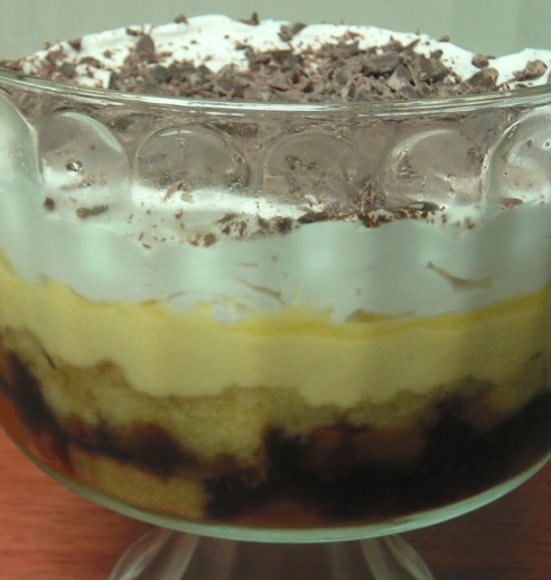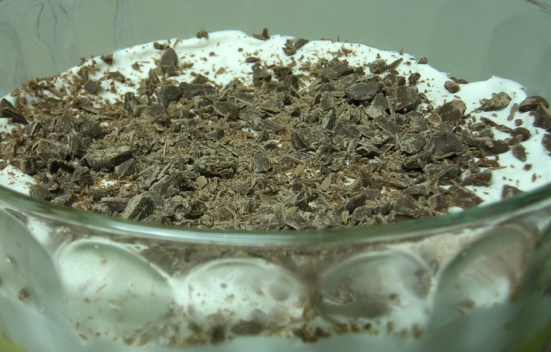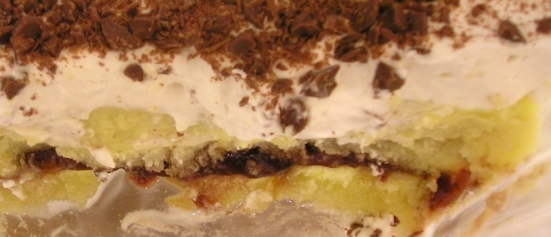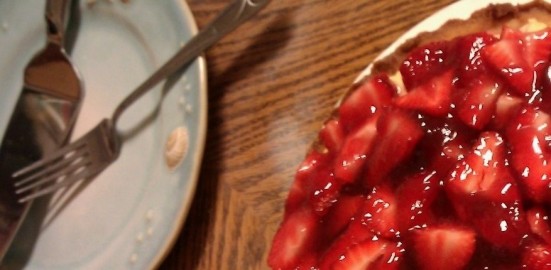
Born to be wild. Always.
Fall is well into its stride, and thus summer berries are at an end, but I am compelled to write about this amazing dessert nonetheless. It’s an intriguing study in contrasts – light yet filling (one piece is enough), pleasantly sweet but not overpoweringly so. All the components get a say, so we hear from vanilla, butter, and fruit in equal measure with sugar. I find that as time passes, I’m more interested in desserts that have more to offer in terms of flavour than just sweetness. For example, the mocha buttercream brownies I just wrote about are sweet, to be sure, but have many flavour notes besides sugar.
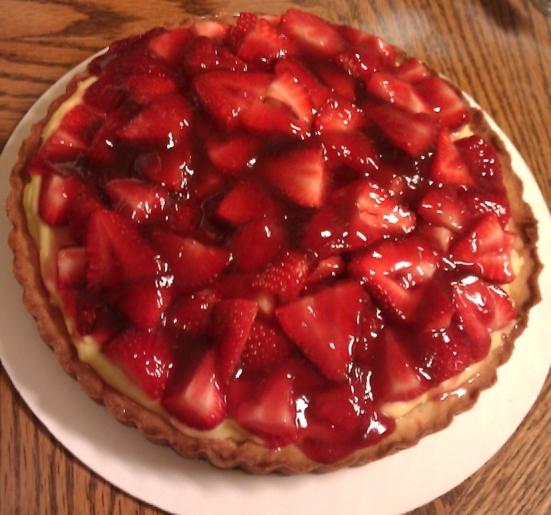
Mr. DeMille, we’re ready for our close-up!
The crust is the best vanilla tart crust I’ve come across to date, but I think that the magic of this dessert is the pastry cream. This is the stuff in éclairs and in every self-respecting Boston Cream Pie! It can be used to fill cakes, pies, and tarts (case in point!), and cover scones – and generally just make life beautiful. Pastry cream was one of those things that scared the daylights out of me when I began to expand my baking repertoire – and oh, there is always so much more to learn! – because it seemed to me that an egg-based custard cooked over the stove could go wrong in so many ways. And I’ll not gild the lily: It took me three tries to finally get my pastry cream to work for me. Irony of ironies, I was so afraid of overcooking the pastry cream that I undercooked it, and it never thickened.
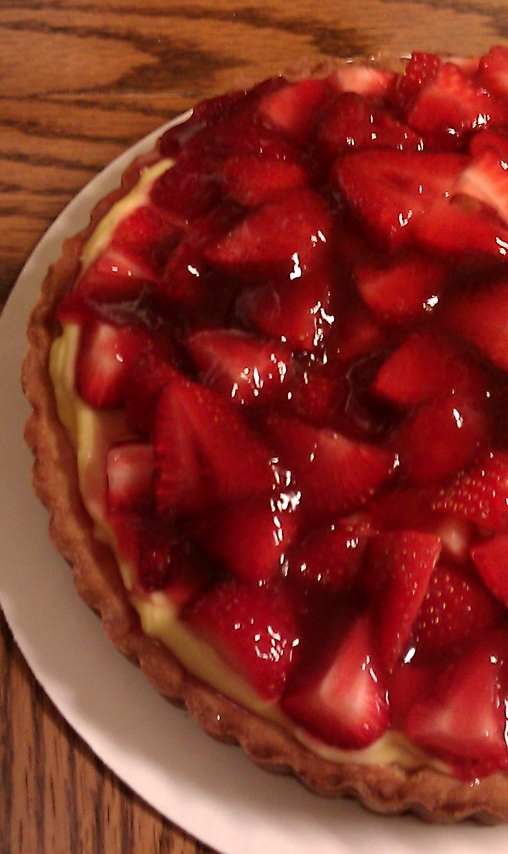
The plump, smiling strawberries! They are glazed with jelly and are thus very glossy.
Here is how you make pastry cream: Egg yolks, sugar, and cornstarch are beaten together in a bowl. Heavy cream is warmed to boiling over the stove. The hot cream is slowly added to the egg mixture to temper it; then the resultant mixture is returned to the pot whence the hot cream came, and the whole shebang is cooked over medium heat, with constant stirring, until the mixture starts to boil – yes, boil. This sounds a bit weird, but stay with me. Then you keep cooking the boiling mixture for another 60 seconds, still stirring constantly. You take it off the stove, add butter and flavouring (I usually reach for vanilla, but the choices are endless – I can’t wait to try my hand at chocolate pastry cream), transfer the mixture to a bowl, cover the surface with plastic wrap to prevent a skin forming, and refrigerate until the mixture has thickened.
It may sound a bit complicated, but it really isn’t. Have all ingredients ready to go, including the butter and flavouring (those must be added immediately to the boiling egg mixture once it comes off the stove), and mentally rehearse beforehand the order of operations. At some point here, I’ll have a handy tutorial on how to make pastry cream, but until then, here is Stephanie, the woman behind Joy of Baking (one of my favourite baking sites). Stephanie really knows her stuff! I hope to be as knowledgeable as she is someday. I changed her pastry cream recipe a bit, omitting the fresh vanilla bean (if you use homemade vanilla extract, you’ll get those gorgeous black seeds anyway, plus a stronger vanilla flavour), but the overall methodology is the same.
If you enjoyed reading this, click here to subscribe to my blog. That way, you’ll never miss a post!
Strawberry Tart with Pastry Cream
If fresh strawberries aren’t available, there are many alternative options:
1. Top tart with chocolate ganache
2. Use frozen berries to make a coulis (detailed in this post) & top tart with the coulis
3. Leave tart plain (trust me, it will still blow your mind)
Ingredients:
For the tart shell:
1 large egg yolk
1 TBS heavy cream
1/2 tsp vanilla extract (I finally have a tutorial for making your own vanilla extract! Huzzah!)
1 1/4 cups all-purpose flour, plus more for dusting the work surface
2/3 cup powdered sugar
1/4 tsp salt
8 TBS cold unsalted butter, cut into 1/2-inch cubes
For the pastry cream:
1 1/2 cups half & half OR whole milk (you need some fat in the dairy component for flavour and structural integrity)
4 egg yolks
1/3 cup + 2 TBS sugar
3 generous TBS cornstarch
6 TBS unsalted butter, cut into 6 pieces
2 1/2 tsp vanilla extract
For the strawberry topping:*
1 pint fresh strawberries, hulled, rinsed, and sliced; pat strawberries dry with a paper towel
1/4 cup of your favourite jelly or jam, for glazing the strawberries
*If making a coulis instead, you will need:
2 pints fresh OR frozen fruit, thawed
4 – 12 TBS sugar (different berries require different amounts of sugar – for example, raspberries require more sugar than blueberries or blackberries; you’ll have to taste as you go along and add more sugar if needed)
4 TBS lemon juice
Method:
For the tart shell:
Whisk egg yolk, cream, and vanilla; set aside. Place flour, sugar, and salt in a food processor and pulse to combine. Top with butter pieces and process to cut the butter into the flour until the mixture resembles coarse meal (10 – 15 pulses of 1 second each). With the food processor running, add the egg mixture and process just until the dough comes together, about 12 seconds. Place the dough onto a sheet of plastic wrap and press into a 6″ disc. Wrap tightly in plastic wrap and refrigerate at least 1 hour (or up to 48 hours).
When ready to bake, remove dough from refrigerator and let stand until malleable. Unwrap dough and roll on a lightly floured surface into a 13″ round. Carefully transfer dough to a 9″ tart pan, evenly pressing dough along the bottom of the pan and up the sides. Trim excess dough from top and use these pieces to patch any holes in the dough that may be present. Set the dough-lined tart pan on a large plate or a cookie sheet and freeze for 30 minutes.
Meanwhile, preheat oven to 375°F. Set the tart pan on a baking sheet (if the pan was set upon a baking sheet for freezing, then just use this same sheet) and line the frozen shell with aluminum foil, ensuring that the edge of the dough is covered with foil. Line bottom of tart pan with pie weights (I always use dried beans as I don’t have any pie weights). Bake for 30 minutes, rotating halfway through baking time. Remove from oven and carefully remove pie weights and aluminum foil. Return tart pan to oven and bake until the tart shell is a deep golden brown, about 5 minutes longer. Transfer to a wire rack and cool completely.
For the pastry cream:
Place half & half in a medium saucepan over high heat and heat until boiling. Meanwhile, whisk yolks and sugar until thoroughly creamed and pale yellow, about 2 minutes. Add cornstarch and continue whisking until completely incorporated.
Once the half & half is just boiling, take it off the stove and slowly stream the hot liquid into the yolk mixture, whisking the yolk mixture constantly to avoid the yolks’ curdling. Immediately return the yolk / half & half mixture to the hot saucepan and cook on medium to medium-high heat, whisking constantly, until the mixture starts to boil. This usually takes me 10 – 15 minutes on medium-high heat, but it takes nearly 30 minutes on medium heat. Once the mixture is boiling, continue cooking, still whisking constantly, for another 60 seconds. Remove from stove and immediately whisk in the butter pieces and the vanilla until fully blended. (This is why you should have everything ready to roll: The butter and vanilla must be stirred in as soon as the yolk / half & half mixture comes off the stove.)
Immediately transfer the hot pastry cream to a bowl and cover with plastic wrap to prevent a skin from forming. Refrigerate until the pastry cream is cooled and thickened, at least 6- 8 hours. Important: Consume the pastry cream within 72 hours! Pastry cream starts to deteriorate rapidly after two to three days.
For the coulis (if not using fresh fruit):
Combine all ingredients in a medium, heavy-bottomed, non-reactive saucepan and cook over medium heat, stirring occasionally, until fruit is mostly dissolved and the mixture has reduced and thickened. This should take about 30 – 45 minutes. If desired, strain the mixture (this is unnecessary if you’re using strawberries or blueberries, but is a good idea if you’re using raspberries or blackberries). Discard seeds. Taste mixture and add more sugar or lemon juice, as needed. Cover and refrigerate until ready to use. Note: The coulis can be made 2 – 3 days ahead of when it will be needed.
Assembly:
Fill cooled tart shell with the thickened pastry cream and top pastry cream with fresh fruit.** (The fruit must be patted dry to prevent it bleeding excessively into the pastry cream, which would become watery.) Microwave the jam or jelly until liquid (about 15 – 25 seconds on high; the timing of this will depend on your microwave), and, using a pastry brush, brush the jam or jelly atop the fruit. Let cool. Serve and enjoy! 🙂
**If using a coulis instead of fresh fruit, top pastry cream with cooled coulis. The coulis goes well with sweetened whipped cream.
Sources: Tart shell and overall concept from Annie’s Eats; pastry cream heavily adapted from Joy of Baking

